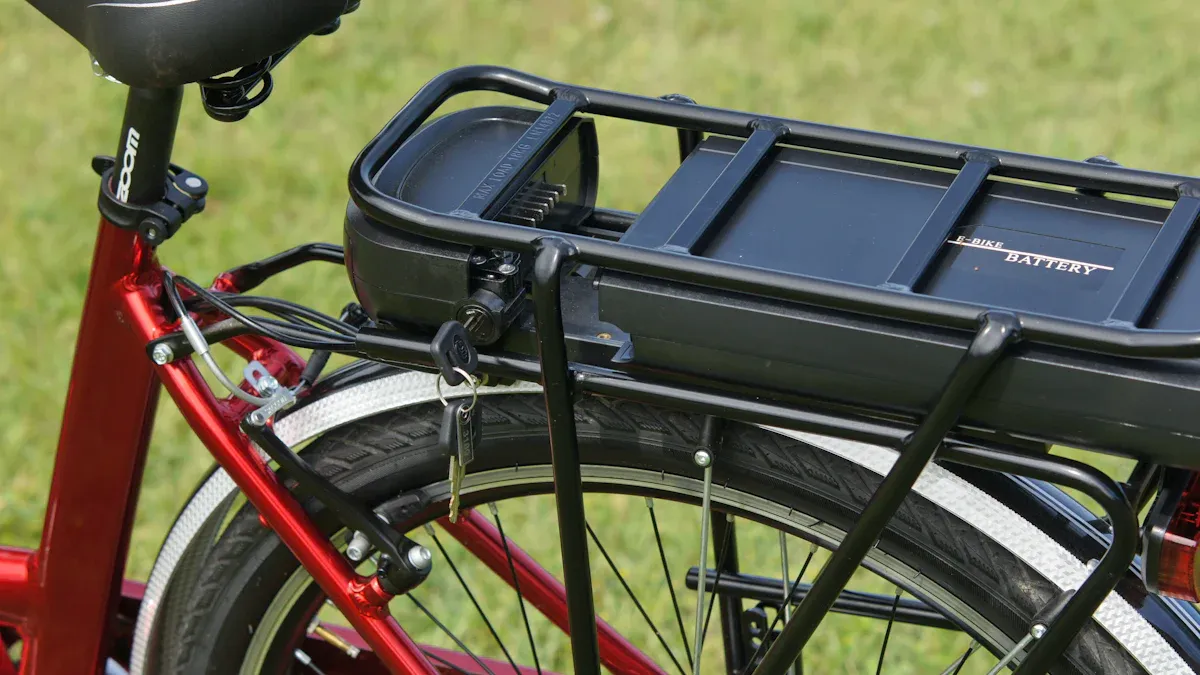
You demand batteries that are truly built to last when powering robots in unforgiving environments. Extreme heat, cold, vibration, and moisture push standard solutions beyond their limits. Advanced lithium battery packs, such as LiFePO4, deliver the built to last performance you require. These batteries provide high energy density and long cycle life. See how they compare:
Feature | Advanced Lithium (LiFePO4) | Traditional Lead Acid |
|---|---|---|
Thermal Stability | High (up to 55°C) | Low (cycle life reduced by 80% at high temps) |
Cycle Life | Long | Short |
Risk of Thermal Runaway | None | Present |
Hazardous Spills | None | Possible |
Energy Density | Higher | Lower |
You trust built to last technology to keep your robotic systems running reliably. Built to last solutions set the standard for safety, adaptability, and endurance.
Key Takeaways
Choose advanced lithium batteries like NMC for their high energy density and long cycle life, ensuring reliable power in harsh environments.
Consider environmental factors such as temperature, humidity, and vibration when selecting batteries to avoid unexpected failures and costly downtime.
Utilize modular battery systems that allow for real-time scaling of power resources, enhancing efficiency across various robotic applications.
Implement robust battery management systems and thermal management solutions to ensure safety and performance in demanding conditions.
Stay informed about innovations in battery technology, such as solid-state batteries and new chemistries, to maintain a competitive edge in robotics.
Part 1: Built to Last in Harsh Environments

1.1 Environmental Challenges
You face a range of environmental stressors when deploying robotics in the field. These stressors can quickly degrade battery performance and reliability. The most common challenges include:
Temperature fluctuations
High humidity
Dust and debris
Constant vibration
Robotic systems often operate near high-power actuators, which generate significant heat. Overheating can reduce the efficiency of batteries and shorten their lifespan. In many industrial and security applications, you must also contend with dust, moisture, and mechanical shocks. These factors combine to create a harsh environment that tests the limits of conventional power solutions.
Temperature extremes present a unique threat. Extremely low temperatures can cause lithium plating, which leads to capacity loss and potential short circuits. High temperatures accelerate chemical reactions inside batteries, resulting in faster aging and a shorter operational life. In severe heat, you risk thermal runaway, a dangerous condition that can compromise safety.
Tip: Always consider the full range of environmental factors when selecting batteries for robotics. Ignoring these variables can lead to unexpected failures and costly downtime.
1.2 Standard Batteries: Key Limitations
Standard commercial batteries often fall short in demanding robotic environments. You may notice several limitations that impact both performance and operational efficiency.
Limitation | Description |
|---|---|
Weight | Batteries are heavier and occupy more space than fossil fuels, making them less efficient for robots. |
Energy Density | Current energy density of batteries is insufficient for the power needs of robotics. |
Need for New Chemistries | Emerging demands of robotics require new types of battery chemistries to be developed. |
The energy density of lithium-ion batteries remains inadequate for many robotics applications. You may find that standard batteries cannot deliver the required power for extended missions or heavy-duty tasks. As robotics technology advances, you need batteries that offer higher energy density, lighter weight, and improved durability. Without these improvements, your systems may experience reduced uptime and increased maintenance.
Part 2: Engineering Rugged Batteries

2.1 Durability and Protection
You need batteries that withstand the toughest conditions in robotics. Durability starts with precise engineering and robust battery materials. Advanced lithium-ion batteries and solid-state designs use specialized materials manufacturing to ensure long-term reliability. You benefit from features that minimize measurement error and provide real-time monitoring throughout the battery’s life cycle.
Feature | Benefit |
|---|---|
Low total measurement error (TME) | Accurate monitoring over battery lifetime |
Simultaneous and continuous cell voltage measurements | Real-time data for better management |
Built-in isoSPI interface | Robust communication |
Hot plug tolerance without external protection | Safe battery replacement |
Passive cell balancing | Uniform charge distribution |
Low power cell monitoring | Reduced energy consumption during monitoring |
Low sleep mode supply current | Minimal power usage when inactive |
You rely on advanced composite materials for battery enclosures. These materials shield batteries from physical impacts and chemical exposure. Graphene nanoplatelets improve thermal management and provide electromagnetic interference shielding. Fire-resistant formulations in battery enclosures add another layer of safety. These protective measures ensure your batteries survive mechanical shocks, moisture, and dust in the field.
Note: You should always select battery materials and enclosures that meet or exceed industry standards for durability and protection.
2.2 Energy Density and Efficiency
You demand high energy storage and efficiency for your robotic platforms. Lithium-ion batteries offer energy densities between 160 and 250 Wh/kg, while solid-state batteries can reach up to 800 Wh/kg. This leap in energy storage allows you to maximize run time and minimize weight, which is critical for mobile robotics and security systems.
Battery Type | Energy Density (Wh/kg) |
|---|---|
Lithium-Ion Batteries | 160-250 |
Solid State Batteries | 250-800 |
Recent advances in solid-state battery materials development have pushed energy density even higher, with some prototypes approaching one kilowatt-hour per kilogram. This enhanced capacity supports longer missions and heavier payloads. You also benefit from improvements in mass and volume efficiency, enabling compact battery packs that fit into tight spaces.
Improvement Type | Details |
|---|---|
Energy Density | Increased by 94% |
Run Time | 2.3 kWh enables 5 hours of run time at peak performance |
Mass & Volume Efficiency | Significant energy density improvements in a compact design |
Fast Charge | 2 kW fast charge with active cooling |
Battery Management System | Custom BMS to maintain battery health and optimize performance |
Safety | Multi-layer safety architecture targeting UN & UL safety certification |
Reliability | Survives rigorous environmental, mechanical, and electrical tests |
Cost | 78% reduction in cost over previous model (F.02) |
You gain a competitive edge by choosing batteries with fast charging capabilities and custom battery management systems. These features keep your robotic systems operational with minimal downtime.
2.3 Safety and Thermal Management
You cannot compromise on safety when deploying batteries in robotics. Mechanical damage, electrical abuse, thermal stress, and manufacturing defects are the most common causes of battery incidents. You mitigate these risks by implementing robust battery management systems, early detection sensors, and fire-resistant enclosures.
Common Causes of Battery-Related Incidents:
Mechanical damage from impacts or punctures
Electrical abuse such as overcharging or short circuits
Thermal stress from extreme temperatures
Manufacturing defects like internal short circuits
Mitigation Strategies:
Prevention through advanced battery management systems and strong mechanical designs
Early detection using gas sensors and thermal monitoring
Suppression with specialized agents and automated flooding systems
Containment using fire-resistant enclosures and thermal barriers
Thermal management is essential for maintaining battery safety and performance. You use thermal interface materials (TIMs) such as gap fillers, thermal pastes, flexible graphite sheets, and thermally conductive adhesives. These materials optimize heat transfer between cells and cooling plates, preventing overheating and extending battery life.
Tip: Always integrate advanced thermal management solutions into your battery packs to ensure safe operation in high-demand environments.
2.4 Adaptability for Robotics
You require batteries that adapt to a wide range of robotic applications. Modular battery systems use smaller, interchangeable modules, allowing you to scale power resources in real time. This flexibility means you can configure batteries to meet the specific energy storage and charging needs of each mission, whether in medical, industrial, or security sectors.
Modular battery systems consist of smaller, interchangeable modules for easy adjustment.
You can scale power resources without a complete system overhaul.
Robots performing different tasks can reconfigure batteries to match energy demands, improving efficiency.
You also benefit from Department of Defense projects like DIU’s Jumpstart for Advanced Battery Standardization and the FASTBat Project. These initiatives focus on integrating commercial batteries into military platforms and streamlining procurement. By following these standards, you ensure your battery packs meet rigorous military specifications for adaptability and reliability.
Project Name | Description |
|---|---|
DIU’s Jumpstart for Advanced Battery Standardization | Prototyping commercial batteries to electrify military platforms, focusing on integration and military specifications. |
FASTBat Project | Streamlining battery procurement and integration, enhancing supply chain efficiency and increasing demand for commercial batteries. |
Note: Always select battery materials and modular designs that align with industry and military standards for maximum adaptability.
Part 3: Innovations in Battery Technology
3.1 New Chemistries and Materials
You see rapid progress in battery chemistry for robotics. Solid-state batteries now offer a much longer lifespan, with up to seven times more recharge cycles than traditional lithium-ion options. The solid electrolyte in these batteries is fireproof, which greatly improves safety for your robotic platforms. Zinc-air batteries provide a cost-effective solution and deliver high power output. Their power comes from the oxidation of zinc, but you should note that this process can cause performance to drop over time.
You also benefit from new materials like biomorphic and metal-air scavenger electrodes. Biomorphic batteries mimic biological fat reserves, boosting energy capacity while reducing weight and space. This approach can give your robots up to 72 times more power capacity than standard lithium-ion batteries. Metal-air scavenger technology lets robots break down chemical bonds in metals to generate energy, allowing them to “forage” for power in the field. This method increases energy density and supports longer, more efficient operations. Metal-air scavenger systems can achieve a power density ten times greater than top energy harvesters and thirteen times more than lithium-ion batteries, which is vital for miniaturized robotics.
3.2 Conformal and Multifunctional Designs
You need batteries that fit seamlessly into compact or irregularly shaped robotic systems. Conformal battery designs use advanced manufacturing techniques and materials to adapt to various shapes and contours. These designs optimize space and improve portability, making them ideal for military, medical, and wearable robotics.
Conformal batteries enhance adaptability to complex geometries.
They maximize space, supporting more efficient compact robotic systems.
Lightweight and portable, they provide a large power reservoir for uninterrupted operation.
Multifunctional battery systems further support your needs by integrating energy storage with load-bearing functions. This reduces total device weight and allows for free-form components that fit complex spaces. Carbon fiber materials boost both energy storage and mechanical strength.
Contribution | Description |
|---|---|
Weight Reduction | Multifunctional batteries combine energy storage and structural support. |
Space Optimization | Free-form components maximize space use in robotic designs. |
Material Use | Carbon fiber increases energy storage and structural integrity. |
3.3 Case Studies: Real-World Results
You can see the impact of these innovations in real-world robotics. Vanguard batteries in demolition robots improve operational efficiency and allow for smooth movement across job sites. ARE demolition robots can operate and charge at the same time, which reduces downtime and boosts productivity. Operators save at least one hour in a typical eight-hour shift compared to cable-powered robots.
To measure battery success in the field, you track key metrics:
Metric | Description |
|---|---|
Battery temperature | Shows thermal state, affecting performance and safety. |
Battery status | Indicates charging or discharging, crucial for management. |
Percent charged | Reflects current charge level, essential for planning. |
Voltage | Measures electrical potential, important for battery health. |
Current (A) | Indicates electric charge flow, relevant for usage analysis. |
Charge (Ah) | Represents total charge capacity, vital for estimating runtime. |
These metrics help you ensure your battery packs deliver reliable, safe, and efficient power for every robotic application.
Part 4: Accelerating Battery Development
4.1 Automated and Robotic Labs
You see rapid progress in battery development thanks to automated and robotic laboratories. Platforms like Aurora transform the way you approach electrochemical research. These labs handle repetitive tasks with precision, freeing you to focus on data analysis and innovation. You can synthesize and test a wide range of battery materials quickly, which boosts throughput and reliability in manufacturing.
Automated labs streamline the battery development process.
Aurora can test various battery materials, accelerating electrochemical research.
Integration with data management systems allows you to monitor and evaluate battery cell development efficiently.
Future advancements will let Aurora select experiments and materials autonomously. This capability will further speed up the search for new lithium battery chemistries for robotics, medical, and security systems. You benefit from faster cycles of innovation and more reliable results.
Artificial intelligence also plays a key role in optimizing electrochemical research. You can see how researchers at Carnegie Mellon University paired a robot named Clio with an AI system called Dragonfly to improve battery electrolytes. The system analyzes data and suggests improvements, which you implement in new samples. This process allows you to explore billions of combinations, far beyond human capabilities.
Evidence Description | Key Findings |
|---|---|
Clio and Dragonfly optimize battery electrolytes for robotics. | |
AI analyzes data and suggests new experiments. | Rapid experimentation reduces development time. |
Focus on ionic conductivity for faster recharging. | System explores billions of combinations for material discovery. |
4.2 Testing and Validation
You rely on rigorous testing protocols to validate battery performance for robotics. High-performance lithium battery packs undergo critical safety tests to ensure they do not overheat and maintain structural integrity. You use tests like the nail penetration test to simulate real-world conditions, such as sudden impacts or internal short circuits. These tests are essential for confirming reliability in manufacturing and deployment.
Accelerated life testing methods help you predict battery longevity in robotic systems. You estimate the remaining useful life (RUL) of lithium-ion batteries, which impacts system availability and safety. You use degradation models and accelerated degradation tests (ADT) to characterize battery wear under different usage and environmental conditions.
Evidence Description | Key Points |
|---|---|
Degradation Models and RUL Predictions | RUL estimation supports predictive maintenance and safety. |
Accelerated Degradation Tests (ADT) | ADTs improve reliability of RUL predictions. |
Input Features for RUL Models | Sliding window data from aging tests enhances accuracy. |
You use these protocols to ensure your lithium battery packs meet the demands of robotics, medical, and industrial sectors. You gain confidence in battery safety, efficiency, and long-term performance through advanced electrochemical research and manufacturing standards.
You drive battery innovation by choosing custom lithium battery packs with advanced safety features and robust management systems. Ongoing collaboration between engineers and scientists leads to stretchable, multifunctional batteries that fit complex robotic designs. To prioritize safety and efficiency, you should adopt AI-driven protocols and standardized architectures. Watch for trends like solid-state batteries, fast-charging solutions, and eco-friendly chemistries. The global robot battery market will grow rapidly, reaching $12 billion by 2028, as you demand reliable, adaptable power for robotics.
FAQ
What makes lithium battery packs suitable for harsh robotic environments?
You benefit from lithium battery packs engineered for durability, high energy density, and advanced thermal management. These features ensure reliable operation in robotics, medical, and security systems, even when exposed to extreme temperatures, vibration, or moisture.
How do you ensure safety in lithium battery packs for robotics?
You rely on robust battery management systems, fire-resistant enclosures, and advanced thermal interface materials. These measures prevent overheating and electrical faults, which helps maintain safety and performance in robotic spacecraft and industrial robots.
Why is energy density important for robotic applications?
You need high energy density to maximize run time and minimize weight. Lithium battery packs with higher energy density support longer missions and heavier payloads, which is critical for platforms like the mars sample return lander or the mars 2020 ingenuity helicopter.
What role does electrochemical energy storage play in robotics?
You use electrochemical energy storage to provide consistent, efficient power for robotics and infrastructure. This technology supports rapid charging, long cycle life, and adaptability across medical, security, and industrial sectors.
Can lithium battery packs be customized for unique robotic platforms?
You can configure modular lithium battery packs to fit specific requirements. Custom robotic battery allows you to optimize voltage, capacity, and form factor for your unique robotic application.




